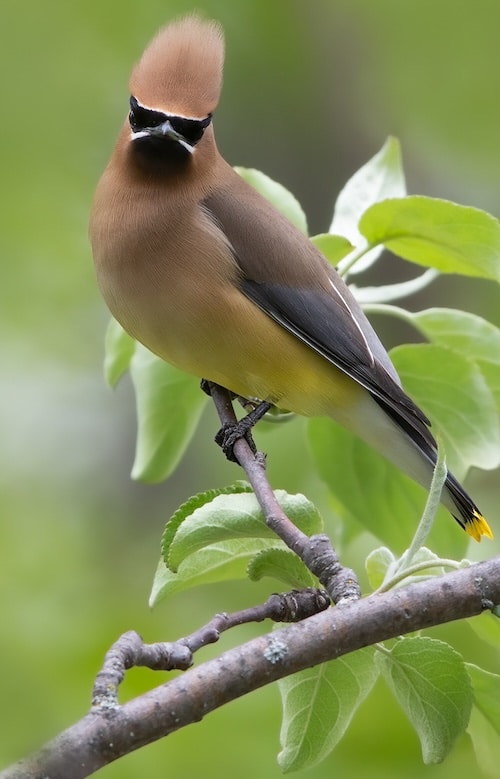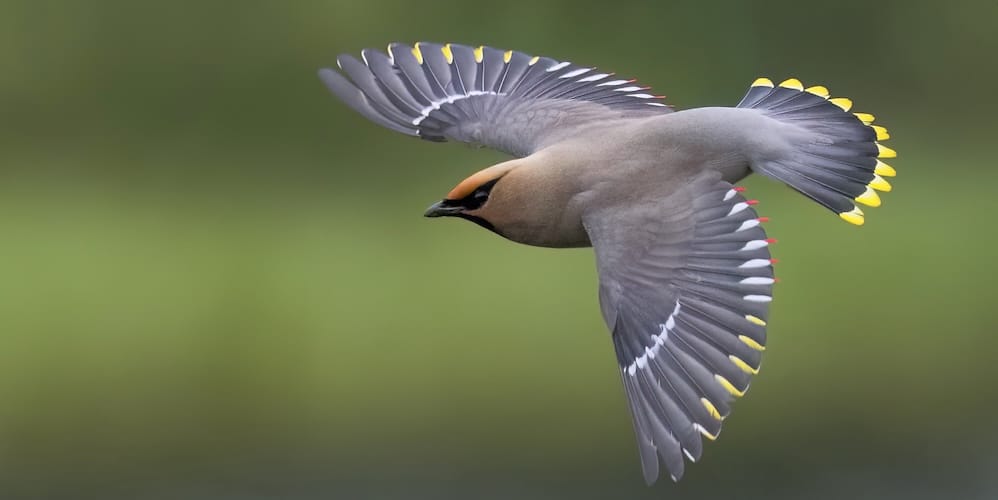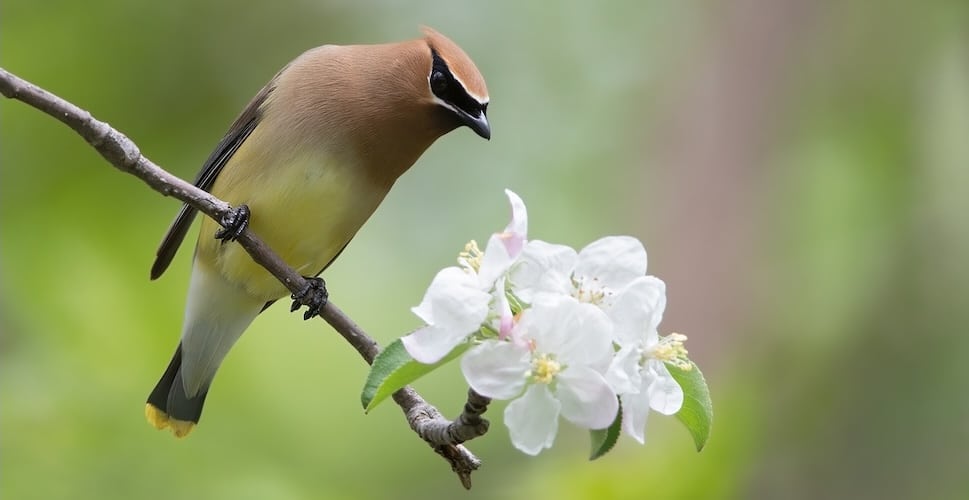Bombycillidae – Waxwings

Bombycillidae commonly called waxwings are passerines in the genus Bombycilla. According to most authorities, this is the only genus placed in the family Bombycillidae, although Phainoptila was sometimes previously included.
According to most authorities, this is the only genus placed in the family Bombycillidae, although in the past the family was extended to include related taxa that are now usually included in separate families: Ptiliogonatidae (Silky Flycatchers), Hypocoliidae (Hypocolius), Hylocitreidae (Hylocitrea), Dulidae (Palmchats) and the Mohoidae (Hawaiian Honeyeaters).
There are three species: the Bohemian, Japanese and Cedar Waxwings. They are not long-distance migrants, but move nomadically outside the breeding season. They mostly feed on fruit.
They are pinkish-brown and pale grey with distinctive smooth plumage in which many body feathers are not individually visible, a black and white eyestripe, a crest, a square-cut tail, short and strong legs and pointed wings. The male and female have the same plumage. Some of the wing feathers have red tips, the resemblance of which to sealing wax gives these birds their common name. Calls are high-pitched, buzzing or trilling monosyllables.

Bohemian Waxwing Bombycilla garrulus – ©Dubi Shapiro
They are arboreal birds that breed in northern forests. Their main food is fruit, which they eat from early summer (strawberries, mulberries, and serviceberries) through late summer and autumn (raspberries, blackberries, cherries, and honeysuckle berries) into late autumn and winter (juniper berries, grapes, crab apples, mountain ash fruits, rose hips, cotoneaster fruits, dogwood berries, and mistletoe berries). They pluck fruit from a perch or occasionally while hovering. In spring they replace fruit with sap, buds, and flowers. In the warmer part of the year, they catch many insects by gleaning or in midair, and often nest near water where flying insects are abundant. They will catch insects at any time of the year when they are more easily available than fruit.
Waxwings also choose nest sites in places with rich supplies of fruit and breed late in the year to take advantage of summer ripening. However, they may start courting as early as the winter. Pairing includes a ritual in which mates pass a fruit or small inedible object back and forth several times until one eats it (if it is a fruit). After this they may copulate. So that many birds can nest in places with good food supplies, a pair does not defend a territory, perhaps the reason waxwings have no true song, but a bird may attack intruders, perhaps to guard its mate. Both parents gather nest materials, but the female does most of the construction, usually on a horizontal limb or in a crotch well away from the tree trunk, at any height. She makes a loose, bulky nest of twigs, grass, and lichen, which she lines with fine grass, moss, and pine needles and may camouflage with dangling pieces of grass, flowers, lichen, and moss. The female incubates, fed by the male on the nest, but once the eggs hatch, both birds feed the young.

Cedar Waxwing Bombycilla cedrorum – ©Dubi Shapiro
They are not true migrants, but wander erratically outside the breeding season and move south from their summer range in winter. In poor berry years huge numbers can erupt well beyond their normal range, often in flocks that on occasion number in the thousands. For example, birds native to Scandinavia and Russia can turn up in Great Brittain in large flocks, even in city centres if there are fruiting trees, and such times are called Waxwing Winters.
Waxwings are perhaps best known during the non-breeding season, when nomadic flocks, sometimes brighten winter days as they descend upon fruiting trees across the Northern Hemisphere, and sometimes get drunk on fruit that has fermented. More reliant on fruit than any other Northern Hemisphere birds, waxwings are the only birds outside the tropics to feed fruit to their young. Close up, one can see tiny drops of intense colour on the trailing edge of their wings; these are the bits of keratin, fused in a waxy texture. During the breeding season, waxwings are far less conspicuous, often breeding in a loose aggregation of pairs along streams or forest openings.
-
Number of bird species: 3
(As at October 2025)
According to the recently (2025) amalgamated AviList, there are three species, in one genus in the Bombycillidae family. They are:
Cedar Waxwing Bombycilla cedrorum
Japanese Waxwing Bombycilla japonica
Bohemian Waxwing Bombycilla garrulus
-
Bombycillidae
Family AccountWaxwings are perhaps best known during the non-breeding season, when nomadic flocks, sometimes containing thousands of birds, brighten winter days as they descend upon fruiting trees across the Northern Hemisphere, and sometimes get drunk on fruit that has fermented -
Bombycillidae
Family AccountThe waxwings are three species of passerine birds classified in the genus Bombycilla. They are pinkish-brown and pale grey with distinctive smooth plumage.
Given that this is a very small family with just three species in one genus, Fatbirder provides active links below to all species.
-
Bohemian Waxwing Bombycilla garrulus
Species AccountPlump, smooth-plumaged bird with a sleek crest and white and yellow markings on wings. Mostly clean gray with brighter rusty wash on the face. -
Bohemian Waxwing Bombycilla garrulus
Species AccountThe Bohemian waxwing (Bombycilla garrulus) is a starling-sized passerine bird that breeds in the northern forests of Eurasia and North America. -
Bohemian Waxwing Bombycilla garrulus
Species AccountHow to identify. The Waxwing is a plump bird, which is slightly smaller than a Starling. It has a prominent crest (head feathers that stick up). -
Bohemian Waxwing Bombycilla garrulus
Species AccountSound archive and distribution map. -
Cedar Waxwing Ampelis cedrorum
Species AccountPlump, smooth-plumaged bird with distinctive thin, high-pitched call. Adults have a sleek crest, black mask, pale yellow wash on the belly, and yellow-tipped... -
Cedar Waxwing Ampelis cedrorum
Species AccountThe cedar waxwing (Bombycilla cedrorum) is a member of the family Bombycillidae or waxwing family of passerine birds. -
Cedar Waxwing Ampelis cedrorum
Species AccountSound archive and distribution map. -
Japanese Waxwing Bombycilla japonica
Species AccountThe only waxwing endemic to the old world, this species is similar to its Bohemian relative, but with pink instead of yellow tail tips and a yellow-tinged... -
Japanese Waxwing Bombycilla japonica
Species AccountThe Japanese waxwing (Bombycilla japonica) is a fairly small passerine bird of the waxwing family found in north-east Asia. It feeds mainly on fruit and berries but also eats insects during the summer. The nest is a cup of twigs lined with grass and moss which is built in a tree. -
Japanese Waxwing Bombycilla japonica
Species AccountSound archive and distribution map.
